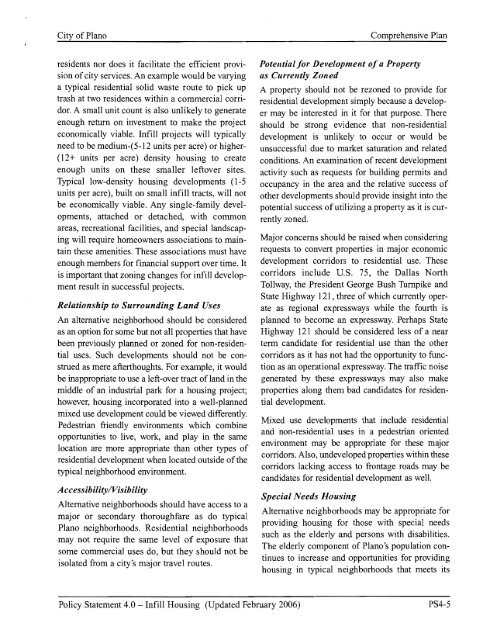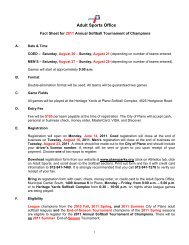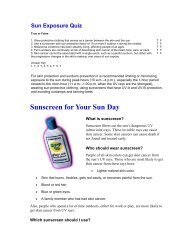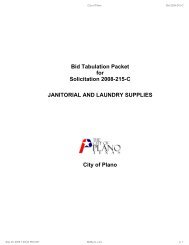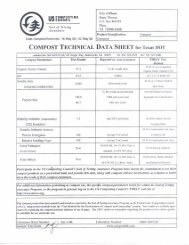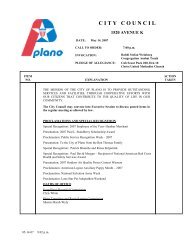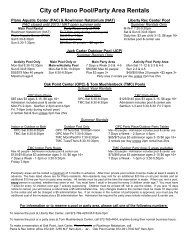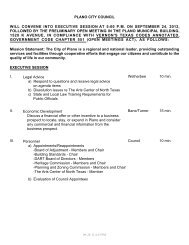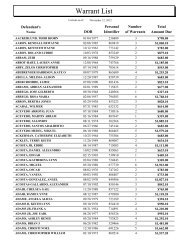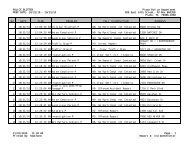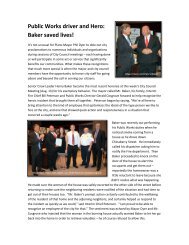R/O-2 - City of Plano
R/O-2 - City of Plano
R/O-2 - City of Plano
You also want an ePaper? Increase the reach of your titles
YUMPU automatically turns print PDFs into web optimized ePapers that Google loves.
<strong>City</strong> <strong>of</strong> <strong>Plano</strong> Comprehensive Plan<br />
residents nor does it facilitate the efficient provision<br />
<strong>of</strong>city services. An example would be varying<br />
a typical residential solid waste route to pick up<br />
trash at two residences within a commercial corridor.<br />
A small unit count is also unlikely to generate<br />
enough return on investment to make the project<br />
economically viable. Infill projects will typically<br />
need to be medium-(5-12 units per acre) or higher<br />
(12+ units per acre) density housing to create<br />
enough units on these smaller leftover sites.<br />
Typical low-density housing developments (1-5<br />
units per acre), built on small infill tracts, will not<br />
be economically viable. Any single-family developments,<br />
attached or detached, with common<br />
areas, recreational facilities, and special lands caping<br />
will require homeowners associations to maintain<br />
these amenities. These associations must have<br />
enough members for financial support over time. It<br />
is important that zoning changes for infill development<br />
result in successful projects.<br />
Relationship to Surrounding Land Uses<br />
An alternative neighborhood should be considered<br />
as an option for some but not all properties that have<br />
been previously planned or zoned for non-residential<br />
uses. Such developments should not be construed<br />
as mere afterthoughts. For example, it would<br />
be inappropriate to use a left-over tract <strong>of</strong>land in the<br />
middle <strong>of</strong> an industrial park for a housing project;<br />
however, housing incorporated into a well-planned<br />
mixed use development could be viewed differently.<br />
Pedestrian friendly environments which combine<br />
opportunities to live, work, and play in the same<br />
location are more appropriate than other types <strong>of</strong><br />
residential development when located outside <strong>of</strong> the<br />
typical neighborhood environment.<br />
AccessibilitylVisibility<br />
Alternative neighborhoods should have access to a<br />
major or secondary thoroughfare as do typical<br />
<strong>Plano</strong> neighborhoods. Residential neighborhoods<br />
may not require the same level <strong>of</strong> exposure that<br />
some commercial uses do, but they should not be<br />
isolated from a city's major travel routes.<br />
Potential for Development <strong>of</strong>a Property<br />
as Currently Zoned<br />
A property should not be rezoned to provide for<br />
residential development simply because a developer<br />
may be interested in it for that purpose. There<br />
should be strong evidence that non-residential<br />
development is unlikely to occur or would be<br />
unsuccessful due to market saturation and related<br />
conditions. An examination <strong>of</strong> recent development<br />
activity such as requests for building permits and<br />
occupancy in the area and the relative success <strong>of</strong><br />
other developments should provide insight into the<br />
potential success <strong>of</strong>utilizing a property as it is currently<br />
zoned.<br />
Major concerns should be raised when considering<br />
requests to convert properties in major economic<br />
development corridors to residential use. These<br />
corridors include U.S. 75, the Dallas North<br />
Tollway, the President George Bush Turnpike and<br />
State Highway 121, three <strong>of</strong> which currently operate<br />
as regional expressways while the fourth is<br />
planned to become an expressway. Perhaps State<br />
Highway 121 should be considered less <strong>of</strong> a near<br />
ternl candidate for residential use than the other<br />
corridors as it has not had the opportunity to function<br />
as an operational expressway. The traffic noise<br />
generated by these expressways may also make<br />
properties along them bad candidates for residential<br />
development.<br />
Mixed use developments that include residential<br />
and non-residential uses in a pedestrian oriented<br />
environment may be appropriate for these major<br />
corridors. Also, undeveloped properties within these<br />
corridors lacking access to frontage roads may be<br />
candidates for residential development as well.<br />
Special Needs Housing<br />
Alternative neighborhoods may be appropriate for<br />
providing housing for those with special needs<br />
such as the elderly and persons with disabilities.<br />
The elderly component <strong>of</strong> <strong>Plano</strong>'s popUlation continues<br />
to increase and opportunities for providing<br />
housing in typical neighborhoods that meets its<br />
Policy Statement 4.0 - Infill Housing (Updated February 2006) PS4-5


